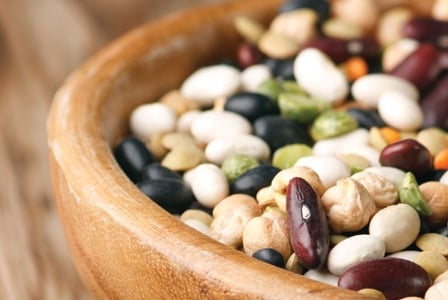
Looking for a nutritious alternative protein source? Look no further than pulse crops: beans, peas, lentils, and chickpeas are loaded with health benefits.
Beans, peas, lentils, and chickpeas are more than alternative protein sources. These important foods, known as pulse crops by the agricultural community, are a triple threat, delivering health, nutrition, and environmental benefits.
Simon Reynolds is a British-trained chef who takes advantage of local and seasonal foods to prepare unique dishes from scratch. Settling in Saskatoon in 2007, he started teaching cooking classes as part of his company, Simon’s Fine Foods, but was surprised to learn that his clients did not know how to cook with the province’s most abundant food crops: chickpeas and lentils.
“They grow more chickpeas than in the rest of Canada, and generally people here don’t know how to cook them,” says Chef Reynolds.
However, residents of Saskatchewan would not be the only Canadians lacking in the culinary art of chickpeas. A 2010 Ipsos Reid study found a lack of knowledge on how to cook or prepare pulses was one of the biggest limitations to consumption and why only one in five Canadians reported eating them in the past six months.
Health benefits
Beans, peas, lentils, and chickpeas, also known as pulses, are often neglected in the diets of Canadians, and it is unfortunate, as they offer tremendous health and nutrition benefits.
Pulses are an excellent source of fibre, both soluble and insoluble, which can help lower blood cholesterol levels while also maintaining bowel health.
Pulses are low in fat with no trans fat; getting protein from vegetable sources reduces the amount of saturated fat that comes from a meat-heavy diet.
Pulses are low-glycemic index foods, which means they release sugar into the blood system slowly, an attribute beneficial to those needing to regulate their blood glucose levels.
Besides being healthy and nutritious, pulses are also beneficial in creating a healthy planet. They are nature’s sustainable food crop because they require low agricultural inputs such as energy or water.
Nitrogen fixer
Pulses are, in fact, the seeds of grain legumes, flowering plants that have the ability to fix their own nitrogen from the air. In basic terms, legumes can take nitrogen gas from the atmosphere and convert it into ammonia, which is then assimilated into the building blocks of life, such as amino acids and nucleotides.
This nitrogen-fixing feature allows farmers to use less nitrogen fertilizer on legumes.
Manager of sustainable production at Pulse Canada, Denis Trémorin, says it is the fuel used in the manufacture of fertilizers that is the most significant contributor to energy use in agriculture, not trucks, as many people mistakenly believe. “Because of the nitrogen fixing, you also see an impact on carbon footprint,” he says.
In addition, when farmers plant legumes as a crop rotation, the plants replenish the soil with nitrogen, further reducing the need for fertilizer.
“Studies show that if you grow peas or lentils in a rotation just one every four years, that farming system will use 22 to 24 percent less non-renewable energy than without,” says Trémorin.
Legumes are also a low water-use crop in that they use the water they get from precipitation efficiently, so there is little need for irrigation.
World exporter
One would think that with Canada having developed a multi-billion dollar pulse industry that Canadians would be consuming this local food crop more frequently. Indeed, Canada has become a top-five exporter of both dry beans and chickpeas, exporting a record 4.1 million tonnes of pulses worth nearly $2.2 billion in 2009.
“Chickpeas and lentils are not in vogue, not seen as a sexy food item,” says Chef Reynolds.
True, pulses may not be sexy, but they soon could be.
Executive chef and co-owner of Mildred’s Temple Kitchen, Donna Dooher, says she has noticed a trend among her patrons. They are eating less meat, so when she opened the Toronto restaurant in 2008, she decided to incorporate more pulses and vegetables into the menu. For example, instead of butter or oil to accompany the bread, there is a marinated olives and white bean purée.
“I see the movement underfoot,” says Dooher. “We may not be there yet, but we are definitely moving in that direction.”
Canadians are continuing to learn about the tremendous health and nutrition benefits from eating pulses regularly.
It is just a matter of time before they learn that pulses are more than a hill of beans. They represent an abundant local food crop that is sustainably grown and part of the solution in creating a healthier planet.
Different types of pulse crops grown in Canada
| Beans | Chickpeas | Peas | Lentils |
|
|
|
|
Source: Pulse Canada
General cooking tips
- Make sure your saucepan is big enough, as pulses double or triple in size during cooking.
- Prevent foaming by adding 1 tsp (5 mL) oil to the cooking water.
- Avoid adding baking soda to shorten the cooking process as it makes the texture of pulses too soft, an undesired side effect.
- Cook pulses slowly, as cooking them too quickly can break the seed coats.
- Cook pulses until tender, but know that cooking times may vary based on a number of factors, including age of the pulses, elevation, and water hardness.
- Add seasonings such as garlic, onion, or herbs while cooking pulses, but avoid tomatoes, vinegar, or other acidic ingredients until pulses are tender. Acids slow the cooking process.
Source: Pulses: Cooking with Beans, Peas, Lentils and Chickpeas, Pulse Canada (available at pulsecanada.com)






